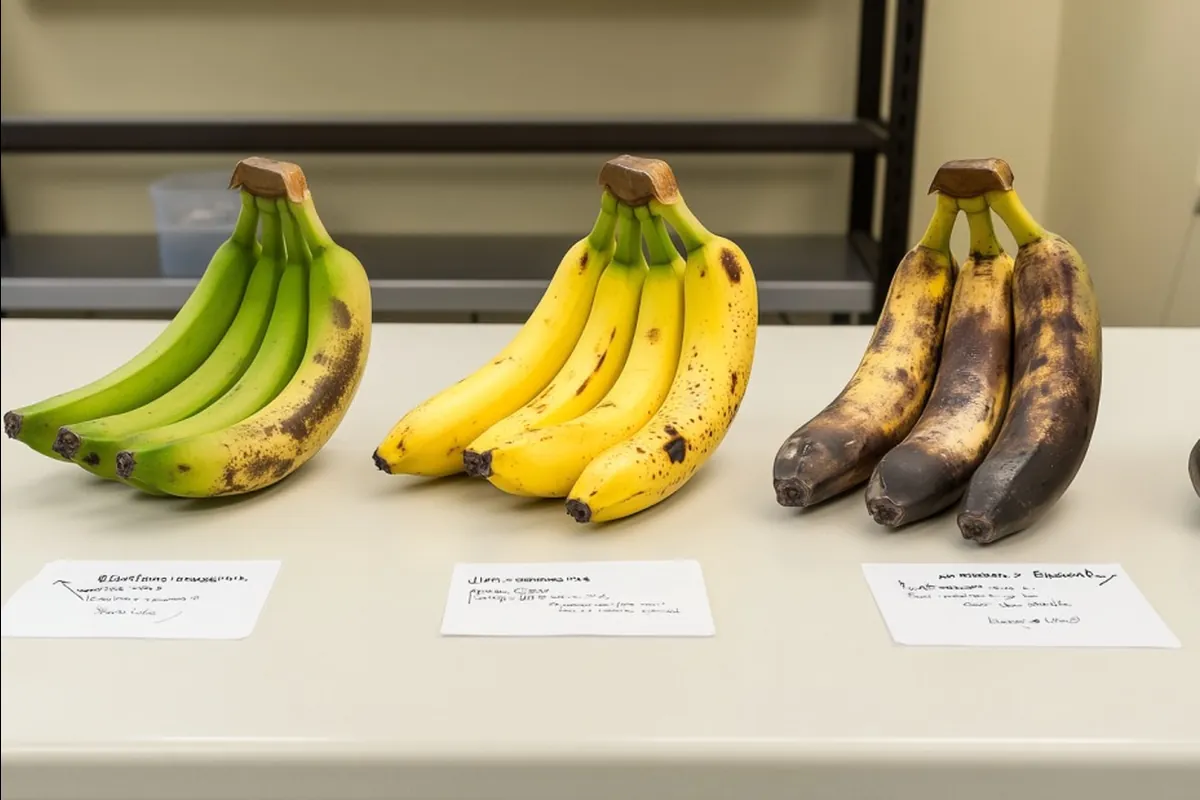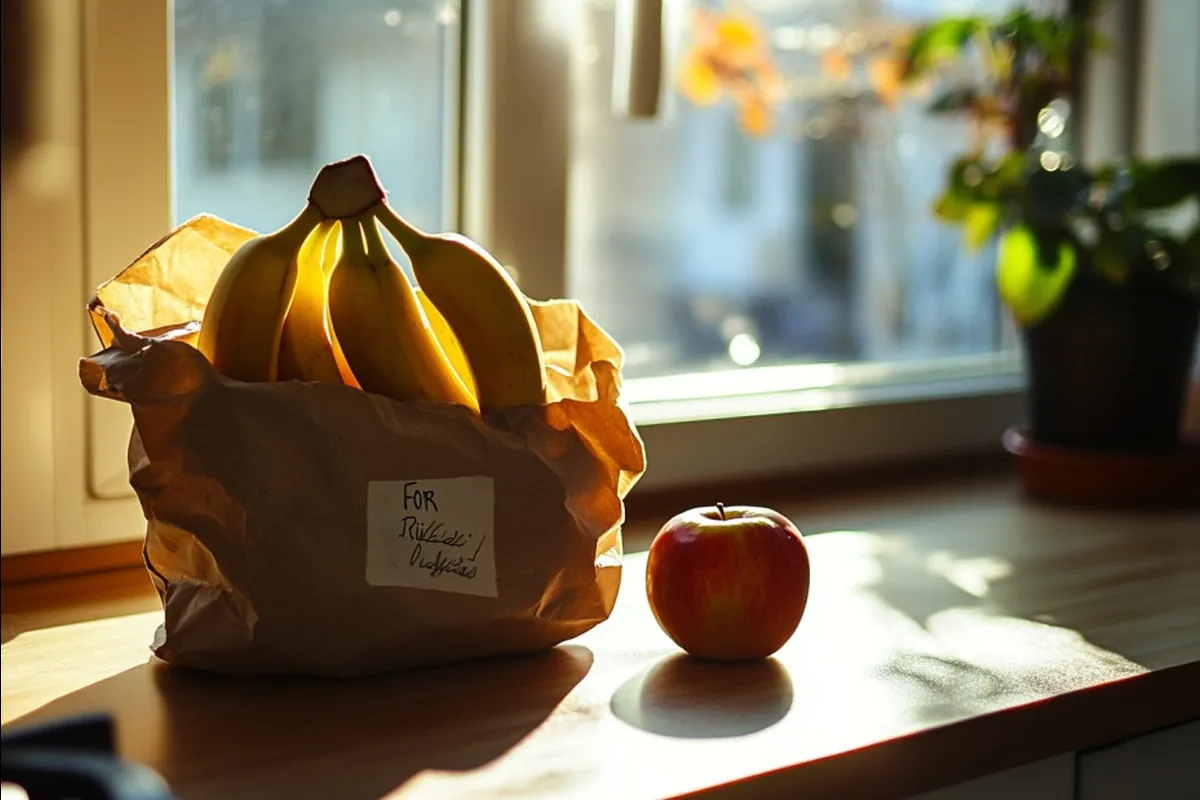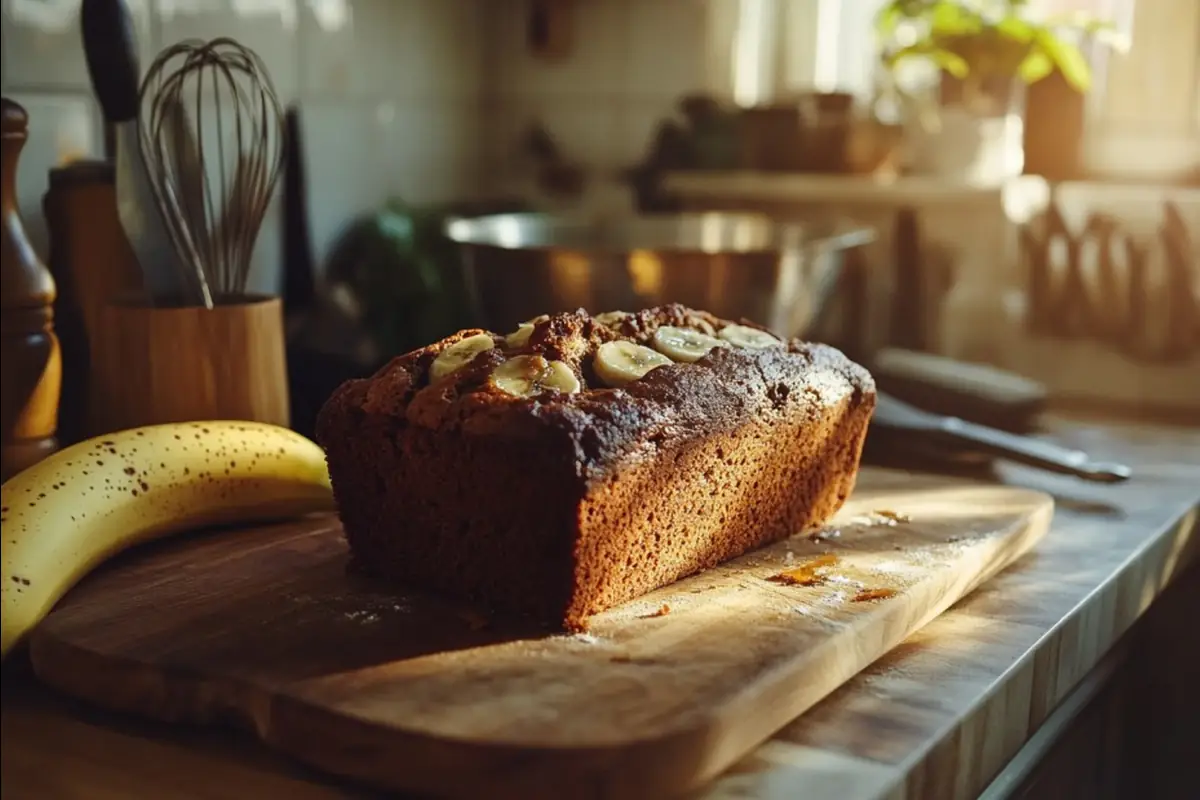I love baking at home and always get excited about using ripe bananas in my banana bread. They add a rich flavor and a moist texture that makes the bread irresistible. But, how ripe do my bananas need to be for banana bread? This is a crucial question that determines the final taste and texture of your loaf.
Getting the right ripeness is key to making the perfect banana bread. Bananas go from green to yellow to brown as they ripen. Each stage changes the flavor and texture of your bread. Let’s look at the science of banana ripeness so you can pick the best bananas for your next banana bread recipes.
Understanding Ripeness and Its Importance
When baking with bananas, knowing when they’re ripe is key. The ripening process turns starches into sugars, making them sweeter and softer. This change affects the taste and texture of your banana bread.
What Makes Bananas Ripe?
Bananas release ethylene gas, speeding up ripening. As they ripen, starch turns into sugars like glucose and sucrose. This makes them sweeter and more flavorful. Ripe bananas are softer, making your baked goods moist and tender.
Why Ripeness Affects Flavor
The ripeness of bananas greatly influences your banana bread’s taste. Ripe bananas have a bright yellow peel with small brown speckles, showing they’re sweet and flavorful. Overripe bananas are sweeter, needing less added sugar.
But, very ripe bananas can taste too strong or even sour, meaning they’re spoiled. Knowing when bananas are ripe is essential for the right sweetness and moisture in your banana bread.
The Science Behind Banana Ripeness
Understanding banana ripeness is key to making the best banana bread. As bananas ripen, they go through a chemical change. This change affects their taste and texture, which are important for baking.
Ethylene Gas and Banana Ripening
The ripening of bananas is caused by ethylene gas. This gas is a natural plant hormone. It starts a series of reactions that break down the bananas’ starches into simple sugars.
This process also softens the fruit’s cells. It’s what makes bananas turn from hard to soft.
The Role of Starch in Bananas
Green, unripe bananas are full of starch. This starch makes them firm. But as bananas ripen, the starch turns into simple sugars.
This change makes the fruit sweeter and softer. It’s why banana bread is so moist and flavorful. The starch-to-sugar change is key for the bread’s texture.
Ripe bananas mix better into batter. This makes the bread moist and even. The starch breakdown also helps the bread’s structure and crumb. It’s a big part of a good banana bread recipe.
Signs of Ripeness for Banana Bread

For the best banana bread, the bananas must be ripe. Look for peels that are mostly brown or black. These bananas should feel soft and smell sweet.
Yellow bananas with brown spots can work too. But, they won’t have the same flavor as fully ripe ones.
The fruit’s texture is also a clue. Ripe bananas are soft and mash easily. Don’t use bananas with mold or a bad smell. They’re spoiled and not good for baking.
Ideal Color for Banana Bread
The best bananas for banana bread have brown or black peels. These bananas are sweet and moist. Yellow bananas with brown spots can also work, but they won’t have the same flavor.
Texture Indicators of Ripe Bananas
- Soft to the touch, with a slight give when gently squeezed
- Easily mashable with a fork or potato masher
- Avoid bananas that are hard or have a green tint, as they are not yet ripe enough
Choosing bananas with the right color and texture will help you make a moist, tasty banana bread. This bread will highlight the natural sweetness of bananas.
Overripe Bananas: Are They Good?
Overripe bananas are a dream come true for banana bread lovers. As they ripen, they get sweeter and more flavorful. This makes them perfect for baking. Plus, they mash up easily, creating a moist and tasty bread.
Benefits of Overripe Bananas
Overripe bananas are a goldmine for bakers. Their high sugar content and soft texture add sweetness and moisture to banana bread. The starch in bananas turns to sugars as they ripen, boosting the flavor.
Using overripe bananas also helps avoid a gummy or starchy texture. This is a common problem with bananas that aren’t ripe enough. Just make sure the bananas aren’t too far gone, with dark peels but still good inside.
When to Avoid Overripe Bananas
- Avoid bananas with mold or a fermented smell, as they’re spoiled.
- Don’t use bananas with dark brown or black fruit inside, as they’re rotten.
- Steer clear of bananas leaking fluids, as they’ve reached the end of their life.
The trick is to pick bananas that are still firm but ripe. They should have no bad smells or visible decay. With the right ripeness, you can make the most of these fruits in your banana bread.
How to Quickly Ripen Bananas

If you need ripe bananas fast for baking, there are quick ways to do it. Bananas are great for baking, from banana bread to banana cream pies. But waiting for them to ripen can be slow. Luckily, there are safe and quick ways to ripen bananas for your baking.
Methods for Accelerating Ripening
One simple way is to put bananas in a paper bag. The bag traps ethylene gas, speeding up ripening. You can also use a plastic bag or wrap bananas in plastic. Adding an apple or pear to the bag helps even more.
Another trick is to keep bananas warm, like on the top of the fridge or near a sunny window. Warmth activates ripening enzymes. Just check them often to avoid overripening.
Safe Ways to Ripen Bananas
- Bake unpeeled bananas at 300°F (150°C) for 15-20 minutes. This works for slightly green or mostly yellow bananas, not green ones.
- Microwave peeled bananas for 30 seconds to 1 minute to soften them quickly. This is good for immediate use, but won’t make them sweeter.
- For slower ripening, store bananas at room temperature, away from sunlight or heat.
These banana ripeness guide tips will get you perfectly ripe bananas for your favorite baking tips. Just watch them closely to avoid mushy, unappetizing bananas.
Storing Bananas: Best Practices
Storing bananas right is crucial for the best taste and texture in your baked goods. The storage method affects how ripe, flavorful, and soft your bananas will be. This is key for making your banana bread ingredients and other treats perfect.
How to Store Bananas for Ripening
For ripening, keep bananas at room temperature, away from sunlight. This slow process takes 2-5 days. Once ripe, refrigerate them to slow down ripening for up to a week.
Storing Overripe Bananas
Overripe bananas are still useful. Peel and freeze them in chunks or slices. This keeps their sweetness and texture for up to 3 months. Use these frozen bananas in smoothies or banana bread ingredients like quick breads and muffins.
| Storage Method | Ripeness Rating (out of 10) | Resulting Texture and Taste |
|---|---|---|
| Freezing | 4/10 | Unripe, starchy, and mushy |
| Refrigerating for 6 days | 5/10 | Firm, crisp, and unripe |
| Storing on the counter for 6 days | 8/10 | Very sweet and soft, ideal for baking |
| Suspending on a hook | 8/10 | Moderately soft with deepened sweetness |
| Wrapping stems in plastic or storing in a bag | 8.5/10 | Slightly soft but sweeter with blackened seeds |
| Storing in foil around stems | 9.5/10 | Firm, deeply sweet fruit with unblemished skin |
Alternatives to Bananas in Banana Bread
Craving homemade banana bread but no ripe bananas? No worries! There are tasty substitutes like applesauce and fruit purees. They add moisture and flavor, making your banana bread delicious.
Applesauce as a Substitute
Applesauce is a simple swap for mashed bananas. Use it in a one-to-one ratio in your banana bread recipes. It brings natural sweetness and a smooth texture, matching the banana’s consistency and taste.
Other Fruit Purees to Consider
Want to try something new? Use mashed avocado, pumpkin puree, or sweet potato puree instead of bananas. These can be great in baking tips for banana bread. Mix and match to find your favorite flavor.
| Substitute | Ratio to Replace Mashed Bananas |
|---|---|
| Plantains | 1:1 |
| Oat powder | ¼ cup per ½ cup mashed bananas |
| Chia “eggs” | 1 tbsp per banana |
| Sweet potatoes | 1:1 |
| Pureed cashews | 1:1 |
| Whole eggs | 1 egg per banana |
Exploring these alternatives lets you enjoy banana bread even without ripe bananas. Get creative and find the perfect substitute for your banana bread recipes and baking tips.
Classic Banana Bread Recipe
Banana bread is a favorite treat that highlights the sweetness and creamy texture of ripe bananas. To make the perfect loaf, choose bananas that are speckled and slightly soft. This ensures the most flavorful and moist banana bread recipes.
Using Ripe Bananas Effectively
Ripe bananas are key to a moist banana bread. Mash them to get about 1 1/2 cups of pulp. This pulp adds natural sweetness and makes the bread tender and moist. Avoid using green bananas, as they make the bread dense and dry.
Tips for Perfecting Your Bread
- Use brown sugar instead of white sugar for added moisture and flavor.
- Gently fold the batter to avoid a tough texture from overmixing.
- Add mix-ins like chopped nuts, chocolate chips, or cinnamon for extra taste.
- Bake until a toothpick in the center comes out clean, usually 60-65 minutes at 350°F (175°C).
| Nutrition Facts | Per Serving | % Daily Value* |
|---|---|---|
| Calories | 279 kcal | 14% |
| Carbohydrates | 40g | 13% |
| Protein | 4g | 8% |
| Total Fat | 12g | 18% |
| Saturated Fat | 7g | 44% |
| Cholesterol | 65mg | 22% |
| Sodium | 344mg | 15% |
Follow these tips and use perfectly ripe bananas. You’ll bake a delicious, moist and tasty banana bread that everyone will enjoy.
Troubleshooting Banana Bread Issues
Making the perfect moist banana bread is all about balance. Knowing how ripe your bananas should be is crucial. If your bananas aren’t ripe enough, your bread will taste less flavorful and be drier. To fix this, add a tablespoon of honey or more sugar to your recipe.
But, if your bananas are too ripe, your bread might be too wet and dense. To fix this, add a bit more flour or less liquid. Also, avoid overmixing the batter to prevent a dense texture.
Common Mistakes with Banana Ripeness
- Using underripe bananas leads to less flavor and moisture in the bread
- Overly ripe bananas can result in a bread that is too moist and dense
Adjusting Recipes Based on Banana Condition
- For underripe bananas, add extra sugar or a tablespoon of honey to compensate
- For overly moist bread due to very ripe bananas, increase the flour slightly or reduce liquid ingredients
- If the bread is too dense, ensure you’re not overmixing the batter
- Adjust baking time based on your oven’s peculiarities and the moisture content of your bananas
Understanding banana ripeness and adjusting your recipe can help you make the moist banana bread you love. With practice and attention to detail, you’ll become a baking tips expert.
Expert Tips for the Best Banana Bread
To make your banana bread amazing, focus on the banana’s ripeness and use some advanced techniques. Adding special flavors and perfecting the texture are key. These tips will help you create the most delicious banana bread you’ve ever had.
Additional Ingredients to Enhance Flavor
Begin by adding a teaspoon of vanilla extract to boost the bananas’ sweetness. A pinch of cinnamon or nutmeg adds a warm, spiced taste that complements the banana. For a nice crunch, mix in some chopped nuts or chocolate chips into the batter.
Perfecting Texture with Banana Ripeness
The ripeness of your bananas greatly affects the texture. Very ripe, almost-black bananas need less sugar because they’re sweeter. For a lighter texture, separate eggs, whip the whites until stiff, and then fold them into the batter gently.
Try using whole wheat or almond flour for different flavors and textures. These flours give your banana bread a richer taste and a moist, dense crumb.
By using these expert tips and the natural sweetness of ripe bananas, you’ll make banana bread that everyone will love.
FAQ
What if my bananas aren’t ripe enough for banana bread?
If your bananas aren’t ripe enough, ripen them quickly by placing them in a paper bag with an apple, or bake them at 300°F for 15-20 minutes.
Can bananas be too brown for banana bread?
Yes, bananas with mold, a fermented smell, or leaking fluids are too brown and spoiled for banana bread.
How to ripen bananas quickly overnight?
Place bananas in a sealed paper bag with an apple to speed up ripening. The ethylene gas will soften and sweeten them by morning.
How do you know when bananas are ripe enough for banana bread?
Bananas are ripe enough when their peels are yellow with brown or black spots, they’re soft to the touch, and mash easily.
Final Thoughts on Bananas for Baking
The best bananas for banana bread are overripe, with brown or black peels. They give the best flavor and moisture. But, slightly less ripe bananas can also make great bread. Try different ripeness levels to find your favorite.
Choosing the Right Bananas for Your Recipe
Banana ripeness changes the bread’s flavor, texture, and sweetness. Overripe bananas make the bread moist and dense. Less ripe ones can make it drier and coarser. Use ripe bananas in many recipes, not just banana bread.
Embracing the Ripe Banana’s Potential
Don’t throw away overripe bananas unless they’re moldy or smell bad. They’re full of flavor and moisture, perfect for baking. Try different ripeness levels to find your family’s favorite banana bread. With a little practice, you’ll make delicious banana treats easily.


2 thoughts on “How Ripe Do My Bananas Need to Be for Banana Bread?”